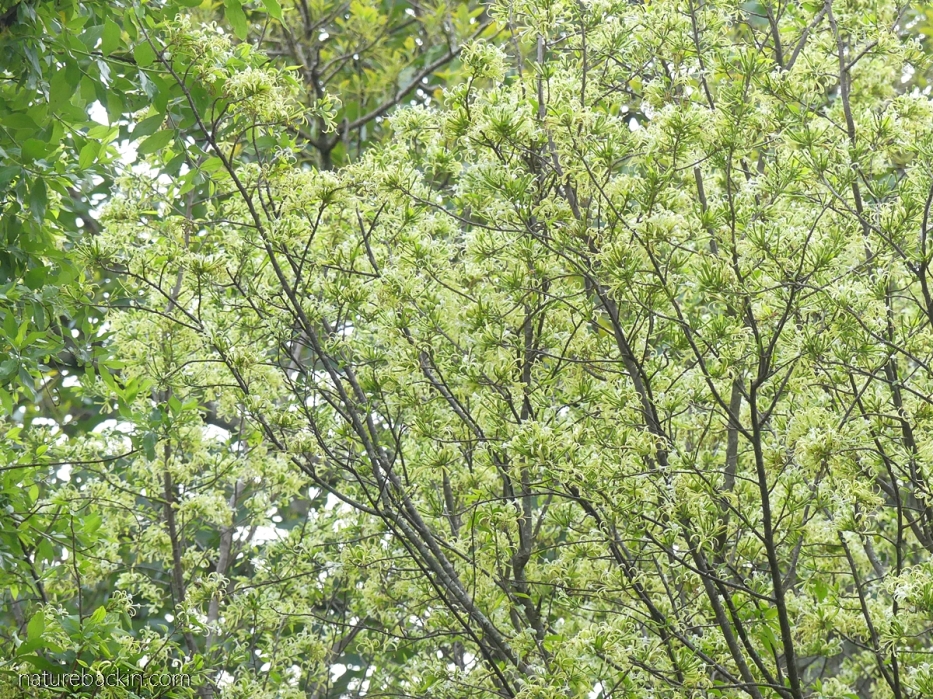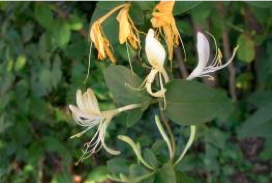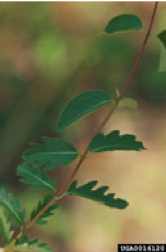Honeysuckles are beloved for their sweetly fragrant, colorful flowers and vining growth habit. However, some invasive varieties like Japanese honeysuckle can wreak havoc in the garden. When seeking the charming look of honeysuckle without the rampant growth, consider these 8 trees with honeysuckle-like blooms.
Trumpet Honeysuckle
This native vine bears clusters of tubular red flowers reminiscent of honeysuckle. The blooms have flared, trumpet-shaped ends, hence the name Trumpet honeysuckle twines gracefully up arbors and trellises, blooming from spring to summer. It attracts hummingbirds and other pollinators
Trumpet Creeper
Trumpet creeper is often mistaken for honeysuckle, with its bright orange, trumpet-shaped flowers borne in clusters. However, this aggressive woody vine needs frequent pruning to prevent it from taking over Hummingbirds relish the nectar-rich blooms
Coral Honeysuckle
The coral honeysuckle species has elongated, paired leaves along vining stems. Showy tubular blossoms in coral, pink, yellow or red shades appear, depending on variety. A favorite of hummingbirds.
Wisteria
Wisteria may be confused for honeysuckle due to its hanging clusters of very fragrant, pea-like flowers in springtime. But this fast-growing, heavy woody vine can damage structures, requiring support.
Japanese Hydrangea Vine
Related to climbing hydrangea, this vine has large leaves and flattened clusters of small white flowers. It can grow 30-50 feet high using aerial rootlets to cling to surfaces.
Virginia Creeper
Virginia creeper is often mistaken for honeysuckle with its five-pointed leaves and bluish berries. This fast-spreading vine can engulf trees and buildings. Foliage turns red in fall. May become invasive.
Crossvine
Crossvine is a flowering woody vine with thick, leathery paired leaves along the stem. Clusters of tubular orange and yellow blooms attract pollinators.
Carolina Jessamine
Also called yellow jessamine, this vine produces abundant yellow, trumpet-shaped blossoms in early spring. The leaves are paired along the stem, similar to crossvine. Can spread aggressively.
When seeking the allure of honeysuckle without the uncontrolled growth, these 8 trees bear flowers with a comparable charm. Trumpet honeysuckle and coral honeysuckle offer a comparable look without the invasiveness. Wisteria, trumpet creeper and Virginia creeper may resemble honeysuckle but can also spread rapidly. Properly identify any lookalikes before planting to avoid unwanted takeovers. Your local extension can provide planting recommendations for your area.
With their abundant, sweetly-scented flowers in shades of yellow, pink, orange and red, it’s easy to see why honeysuckle vines are treasured additions to gardens across many regions. However, some species like Japanese honeysuckle and Amur honeysuckle can grow unchecked, creating upheaval in the landscape.
Fortunately, there are many lookalike plants that emulate the beauty of honeysuckle without the aggressiveness. Trumpet honeysuckle, coral honeysuckle and other vines provide a safer alternative with their charming flowers. Even some trees like redbud and tulip poplar produce honeysuckle-like blooms.
Here are 8 common imposters that get mistaken for honeysuckle:
1. Trumpet Honeysuckle
A native vine, trumpet honeysuckle bears flowers remarkably similar to honeysuckle – clusters of red, tubular blooms with flared, trumpet-shaped ends. It gracefully climbs trellises and arbors, blooming spring into summer. Hummingbirds flock to the nectar-rich flowers. This honeysuckle lookalike lacks the aggressiveness of Japanese honeysuckle.
2. Trumpet Creeper
Another deceiver with “trumpet” in its name, trumpet creeper flaunts bright orange, trumpet-shaped flowers in showy clusters. This fast-spreading woody vine requires frequent pruning to control its rampant growth. The flowers draw in hummingbirds.
3. Coral Honeysuckle
The coral honeysuckle species has elongated, paired leaves along vining stems. Tubular flowers in shades of coral, pink, yellow or red appear, depending on variety. A favorite food source of hummingbirds.
4. Wisteria
Wisteria’s hanging clusters of extremely fragrant, pea-like flowers in spring signal its relation to honeysuckle. However, this vigorous, heavy woody vine can damage structures unless properly supported.
5. Japanese Hydrangea Vine
Related to climbing hydrangea, this vine has large leaves and flattened clusters of tiny white flowers. It can grow 30-50 feet high using aerial rootlets to cling surfaces.
6. Virginia Creeper
Virginia creeper is often confused for honeysuckle with its five-pointed leaves and bluish berries. However, this rapidly spreading vine can engulf trees and buildings. Foliage turns red in fall. Can become invasive.
7. Crossvine
Crossvine is a flowering woody vine with thick, leathery paired leaves along the stem. Clusters of orange and yellow tubular blooms attract pollinators.
8. Carolina Jessamine
Also called yellow jessamine, this vine produces abundant yellow, trumpet-shaped flowers in early spring. The leaves are paired along the stem, resembling crossvine. Can spread aggressively.
Always verify plant identities before allowing unknown vines to establish, avoiding regrets later. Consult your local extension office for the best honeysuckle alternatives to plant in your specific area. With a little care, you can find charming alternatives that bring you joy without the hassle.

at home and further afield

Coming into flower now, after dropping its leaves in the very early spring, is the profusely flowering wild honeysuckle-tree. Flowering on bare stems with the new leaves just starting to sprout it puts on a lovely show.

The flowers of the Wild Honeysuckle-tree (Turraea floribunda) are sweetly fragrant. The petals are a subtle shade of green surrounding a long white central tube that is formed by the stamens fused together. At the end of the stamen tube a frill carries the pollen-bearing anthers. The style, which protrudes beyond the tip of the stamen tube, ends in a small knob-like head that receives pollen spread by visiting pollinators, be they insects or birds. According to Boon, the flowers are pollinated by visiting hawk moths and sunbirds.

In the two sources I consulted, Boon describes the colour of the petals as “creamy-green” and Manning says they are a “delicate pistachio-green”. The flowers are borne in clusters of between 2 to 18 flowers with clusters comprising at first just the long slender buds and then a mixture of buds and fully opened flowers.

With the flowers emerging on the bare stems as the new leaves are just starting to sprout, the clusters of buds and flowers are particularly striking against a blue sky.


But equally the flowers are lovely against the green foliage of the surrounding trees. The honey-suckle tree is a forest species and it occurs in the eastern regions of the Eastern Cape and KwaZulu-Natal in South Africa. Its broader range extends as far north as Sudan.

The ‘floribunda’ part of the honeysuckle-tree’s scientific name means ‘prolifically flowering’ and in the early summer it certainly does live up to its name.



With such a profusion of flowers, it is surprising that I have seen very few fruits on the tree. In fact Manning comments that remarkably few fruits are produced for so many flowers. On our tree I have only noticed one or two of the small fruit capsules per season.

As the fruit ripens it splits along its ribs into a kind of star shape with orange seeds attached to each segment. However, I only have a photograph of the split woody capsule after the seeds have dropped.

A couple of weeks ago I found a dry capsule on the ground beneath the tree. I collected it and snapped a photo of it with my phone this evening.

A previous post on porcupines featured our honeysuckle-tree as the trunk had been gnawed on by a visiting porcupine (or porcupines) and some of the bark had been chewed right off the base of the trunk. Happily the porcupines seem to have lost interest in the tree and it has not shown any subsequent ill effects.
The tree is multi-stemmed and its greyish bark is decorated with lichen. I took the photo below in the early dusk this evening using my cell phone.

I wish I could convey to you the sweet scent of the flowers. It is easy to imagine them attracting night flying insects, such as hawk moths.
Boon notes that roots and bark are used medicinally to treat rheumatism and heart ailments, and it is used magically to induce trance. From my perspective it certainly is an entrancing tree.


Sources:
Boon, Richard. 2010 (2nd ed.). Pooley’s Trees of Eastern South Africa. Durban: Flora & Fauna; Manning, John. 2015. Turraea floribunda. PlantZAfrica. South African National Biodiversity Institute (SANBI). http://pza.sanbi.org/turraea-floribunda

Posted by Carol

Sharing insights and celebrating the creatures and plants that enrich suburban spaces, with s from my previous KZN garden and current Western Cape garden in South Africa, and from wild places further afield.

Why is it called “Japanese”?

Japanese honeysuckle is native to Japan. Although some invasives arrive by accident mixed in with other plant products or on people’s clothing, Japanese honeysuckle was brought to the U.S. on purpose in 1806 for use as an ornamental plant. Because it grows fast, it has also been used for erosion control—but it escaped! The Missouri climate is similar enough to the Japanese climate that it grows well here, and there are no Missouri insects, animals, or diseases that keep it from taking over.

Like bush honeysuckle, Japanese honeysuckle leafs out before most Missouri native plants—it is actually semi-evergreen in the St. Louis area. This gives it a huge growing advantage every spring. It can also trick you into thinking that it is another plant entirely—it tricked me this spring. The early spring leaves on new shoots of Japanese honeysuckle do not look like the leaves that develop later. Instead of being simple oval leaves they are deeply lobed—think miniature oak leaves. Don’t be fooled—pull it out ASAP!
Star Jasmine Care & Growing Tips
FAQ
What flowering tree smells like honeysuckle?
-
Reddit · r/PlantIdentificationhttps://www.reddit.comr/PlantIdentification – What is this tree that smells like honeysuckle? – RedditJun 14, 2024 — Weirdly, in the UK, it’s called a lime tree.
What is a honeysuckle tree?
Honeysuckles are arching shrubs or twining vines in the genus Lonicera (/lɒˈnɪsərə/) of the family Caprifoliaceae.
What plant is mistaken for honeysuckle?
Native dogwoods and viburnums are sometimes confused with invasive shrub honeysuckles because they also have an opposite branch and leaf arrangement.
Is the seven son flower tree invasive?
-
Invasive Potential:The Seven-Son Flower doesn’t have a reputation for aggressive invasion or over-expansion in landscapes.
-
Spread Methods:It can spread through suckers (shoots from the base) that are easily clipped off, and it can also self-sow, but this is less common and easily managed.
-
Growth Habit:It’s a moderate to fast-growing tree, reaching 15-20 feet tall and 8-10 feet wide.
-
Benefits:It offers a variety of seasonal interests, including green foliage, fragrant white blooms, and peeling bark in winter.
-
Care:It’s relatively easy to grow and doesn’t require much maintenance.
What does a honeysuckle tree look like?
The honeysuckle tree is a unique specimen with bountiful branches that reach towards the sky. It is often mistaken for tangling vines, but its distinct features include clusters of tiny, bell-shaped flowers in hues from vibrant reds to delicate creams.
Are honeysuckle trees easy to grow?
Honeysuckle trees are classified as “easy” plants to grow because they are low maintenance and generally grow well on their own with few notable issues. There are both climbing and shrub-type varieties of the plant. We’ve compiled a complete guide to Honeysuckle trees so you can grow a thriving one in your backyard with minimal effort.
Do climbing honeysuckle trees flower?
Climbing Honeysuckle trees (also known as the vine variety) will flower best if planted in areas with direct and constant sunlight. However, remember that pests are far less likely if the plant has some shade but the plant won’t flower as much if it has too much shade, so the choice is yours.
What type of plant is Honeysuckle?
Honeysuckles are shrubby or climbing and vining plants that can be easily trained to climb up a trellis or other support. Some are fragrant, while others are nearly scentless. You may hear them called “woodbine” as well.
What colors do honeysuckle flowers come in?
The honeysuckle tree’s bountiful branches reach towards the sky, dotted with clusters of tiny, bell-shaped flowers that come in hues from vibrant reds to delicate creams.
How tall does a honeysuckle tree grow?
There is a significantly large spectrum for honeysuckle size. These plants can grow upwards of 20 feet, or they can remain somewhat close to the ground and short. The height of the tree depends primarily on its variety. For instance, a vine will grow taller than a shrub. The height also depends on the climate and surroundings of the plant.
